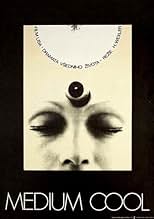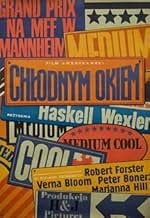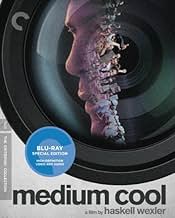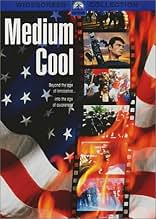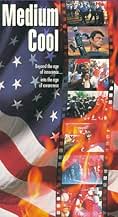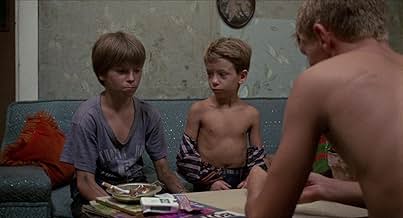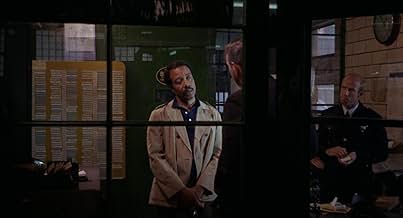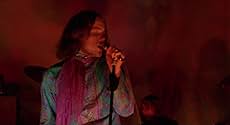NOTE IMDb
7,2/10
5 k
MA NOTE
Ajouter une intrigue dans votre langueA TV news reporter finds himself becoming personally involved in the violence that erupts around the 1968 Democratic National Convention.A TV news reporter finds himself becoming personally involved in the violence that erupts around the 1968 Democratic National Convention.A TV news reporter finds himself becoming personally involved in the violence that erupts around the 1968 Democratic National Convention.
- Réalisation
- Scénario
- Casting principal
- Récompenses
- 2 victoires et 4 nominations au total
Avis à la une
A rare directorial outing by all-time great cinematographer Wexler, this is generally acknowledged as the most politically radical film ever produced by a major studio. In freewheeling, semi-improvised, ideologically calculated scene after scene, it depicts an apolitical television cameraman's awakening of consciousness and abandonment of the role of passive observer. The class and race politics are four notches up on any comparable contemporary studio feature, that's for sure - with the surprisingly patient explanation of how 6-o-clock-news ideology oppresses minority communities, leading in to a love affair with a working-class single mother instead of some vanguard hippie, you could even argue that this Americanization of Godard has better ideological legs than the master himself. Sure it meanders a tad, and the stylistics can date, but there's nothing else in any movie ever that compares with the climax, as the actors make their way through actual documentary footage of the 1968 Democratic convention and attendant street battles. I mean, how did such a finely balanced mix of integrated narrative, Euro-tics, American underground film and straight-up documentary even occur to them? And how did they then manage to actually pull it off with honors? Pretty damned impressive.
This is one of the great American movies. The reasons for its obscurity have everything to do with mass consumerism in the late 20th century and nothing to do with its quality. In my opinion this film captures the essence of the late 1960s better than Easy Rider, The Graduate, or any of the other popular films that have come to be associated with that era.
Wexler combines a very European (Italian Neorealist/French New Wave) style with a very American subject matter in a way that comes across as completely natural. It is an art film that plays like watching the evening news.
It is exciting both formally, and culturally: not only does it provide a lasting document of the late 1960s counter-culture in conflict with the aging, square America of the Eisenhower era, it more specifically does a fine job of representing the more general cultural conflict of rural people (here white Appalachians) thrust into the Yankee city environment.
All this, and the movie is fun to watch, not some intellectualized snorefest. It a great movie.
Wexler combines a very European (Italian Neorealist/French New Wave) style with a very American subject matter in a way that comes across as completely natural. It is an art film that plays like watching the evening news.
It is exciting both formally, and culturally: not only does it provide a lasting document of the late 1960s counter-culture in conflict with the aging, square America of the Eisenhower era, it more specifically does a fine job of representing the more general cultural conflict of rural people (here white Appalachians) thrust into the Yankee city environment.
All this, and the movie is fun to watch, not some intellectualized snorefest. It a great movie.
This film is better upon the second viewing, the first time I saw this I thought it was somewhat dated or boring, I couldn't have been more wrong. Initially I watched this film because it was directed by Haskell Wexler whose work I admire, and I'm from Chicago and had heard it shows much of the city and the riots of 68. I enjoyed seeing the city forty years ago to see what was the same and what had changed, much has changed yet much remains the same from what I have seen of the people, places, buildings etc. It was great to see the Kinetic Playground on there, Chicago's electric ballroom, and other area's such as Lincoln Park. On the second viewing, I realized that this is a very important film in that it adroitly captures a moment in time, a moment we can never have again that is lost forever, that one second in our history that pivoted us as a nation between innocence and awareness and possibly that crucial moment which has brought us to the point we are at today. This movie is very important as a document of history, not to mention how well it's shot. The angles, the color, the way he goes in and out of focus make this a true gem that gets better the more you see it. Great soundtrack as well, Zappa, Mike Bloomfield and others.
Haskell Wexler, a cinematographer by trade, practically invented the technique invented we know today as "cinema verite" with this striking drama that plays so much like a documentary, you'd never guess it was fiction without being told. It's less a story and more a voyeuristic look into the lives of ordinary people thrust into extraordinary circumstances, in this case reporters who are covering a political convention and other Chicago locals who are just minding their own business when the legendary riots break out at the 1968 Democratic National Convention.
Even more groundbreaking is the approach Wexler takes in framing the film's final scenes. He had ample warning that there would potentially be some unrest at the convention, so he decided to thrust his cast right into the thick of it, sending them to the foyer and front entrance of the Chicago Convention Center and the crew right along to film the events. No one knew exactly what would happen, making this perhaps the most creative and timely piece of "improvised" drama in the history of filmmaking up to this point.
Every documentary filmmaker who chooses to make his/her film about actions and events rather than simply a bunch of talking heads owes a debt to Wexler and his creative team on "Medium Cool".
Even more groundbreaking is the approach Wexler takes in framing the film's final scenes. He had ample warning that there would potentially be some unrest at the convention, so he decided to thrust his cast right into the thick of it, sending them to the foyer and front entrance of the Chicago Convention Center and the crew right along to film the events. No one knew exactly what would happen, making this perhaps the most creative and timely piece of "improvised" drama in the history of filmmaking up to this point.
Every documentary filmmaker who chooses to make his/her film about actions and events rather than simply a bunch of talking heads owes a debt to Wexler and his creative team on "Medium Cool".
Movies have a way of capturing the moment better than recreating it. I can only dread what a recreated 1968 in Chicago would look like from a Hollywood perspective. It would probably resemble something out of Forrest Gump. But Medium Cool happened to capture some brutal fight scenes with police in Chicago as well as scenes from the black ghettos. You can't recreate this stuff. This isn't a documentary but cinema verité and combines fiction and non-fictional elements. It's all shot with Chicago of 68 in the background. A landmark and infamous year for the US with the assassinations of RFK and MLK as well as the 1968 Democratic National Convention which was met with severe state repression. The state wasn't negotiating at this time, it was brutally sending men off to war and attacking those at home with the hired goons of the police force.
It's a great movie which manages to combine fiction and non-fiction and shows us what the sixties were really like. It wasn't all love beads and LSD, although there is an amusing psychedelic sequence which takes place in a club.
I think what I liked most was that even people who were non-political were being dragged into the politics of the time. Events were that serious at the time and people had to begin picking sides, the pleasant, white, middle-class interior of the Chicago DNC or outside fighting and raging against the police.
It's a great movie which manages to combine fiction and non-fiction and shows us what the sixties were really like. It wasn't all love beads and LSD, although there is an amusing psychedelic sequence which takes place in a club.
I think what I liked most was that even people who were non-political were being dragged into the politics of the time. Events were that serious at the time and people had to begin picking sides, the pleasant, white, middle-class interior of the Chicago DNC or outside fighting and raging against the police.
Le saviez-vous
- AnecdotesThe line "Look out, Haskell, it's real!" was actually dubbed in after the shooting. It was supposedly what Haskell Wexler was thinking to himself and he wanted to include it.
- GaffesWhen Eileen enters the L looks for Harold, she is wearing a white hair band, but when they show her sitting on the L, the hair band is missing.
- Citations
John Cassellis: If I gotta be afraid in order for your argument to work, then you got no argument.
- Crédits fousStuds Terkel is credited as "Our Man in Chicago".
- Versions alternativesDue to copyright disputes, all video releases feature some different songs on the soundtrack from the theatrical version.
- ConnexionsEdited into The Kid Stays in the Picture (2002)
- Bandes originalesSweet Georgia Brown
by Ben Bernie, Kenneth Casey and Maceo Pinkard
Performed by Brother Bones
Courtesy of Tempo Records
Played during roller derby scene
Meilleurs choix
Connectez-vous pour évaluer et suivre la liste de favoris afin de recevoir des recommandations personnalisées
- How long is Medium Cool?Alimenté par Alexa
Détails
Box-office
- Budget
- 800 000 $US (estimé)
- Durée1 heure 51 minutes
- Mixage
- Rapport de forme
- 1.85 : 1
Contribuer à cette page
Suggérer une modification ou ajouter du contenu manquant

Lacune principale
By what name was Objectif vérité (1969) officially released in India in English?
Répondre

